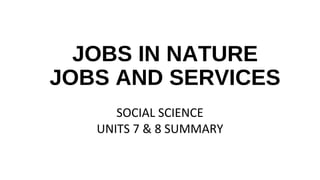Units 7 & 8. Jobs in Nature. Jobs and services.
- 1. JOBS IN NATURE JOBS AND SERVICES SOCIAL SCIENCE UNITS 7 & 8 SUMMARY
- 2. JOBS WHAT DO THEY DO? HE/SHE IS A/ANŌĆ”
- 3. SALARY The money you earn working
- 4. POPULATION AND JOBS ŌĆó Population can be divided into two groups: ŌĆó ACTIVE POPULATION INACTIVE POPULATION ŌĆó Legal working age (16 or over). Not legal working age. ŌĆó Employed (working) or Children under 16 and retired unemployed (looking for a job). people.
- 5. ACTIVE OR INACTIVE POPULATION?? 1 2 16 YEARS OLD GIRL STUDYING 3 4 5 25 YEARS OLD WOMAN LOOKING FOR A JOB 40 YEARS OLD MAN WAITER RETIRED PERSON PICTURE 1 SHOWS A ŌĆ”.. He/She is active / inactive because..
- 6. CLASSIFICATION OF JOBS ŌĆó The active population works in three economic sectors: PRIMARY SECONDARY ŌĆóTERTIARY
- 7. THE PRIMARY SECTOR ŌĆó This obtains products from nature (plants, animals and the ground). It includes jobs in: ŌĆó Crop farming Livestock farming Fishing. Types: Growing plants to Coastal fishing (near the coast) . get different products. Deep sea fishing (a long way These products are crops. from the coast). Fish farm
- 8. What stages in the process of farming do they correspond to? 1 2 3 4 5 6
- 9. The most important stages in the process of farming are: ŌĆó PLOUGHING SOWING HARVESTING ŌĆó Turn the soil to make it Planting seeds in the soil. Harvest the crop. ready for planting.
- 10. LIVESTOCK FARMING = ANIMAL FARMINGŌĆó EXTENSIVE FARMING. Animals live in the open air and eat grass or grain ŌĆó INTENSIVE FARMING. Animals live fenced in on farms or in barns. Animals eat hay or dried feed.
- 11. MATCH THE ANIMALS TO THE TYPES OF LIVESTOCK 1. POULTRY 2. CATTLE 3. SHEEP 4. PIGS 5. GOATS
- 12. MATCH DEFINITION WITH TYPE OF FISHING ŌĆó Fishermen fish near - Fishermen fish a long - Farmers breed fish the coast. way from the coast. and shellfish in these places. ŌĆó A.FISH FARMS B. COASTAL FISHING C.DEEP-SEA FISHING
- 13. JOBS IN THE SECONDARY SECTOR ŌĆó WORKERS TURN RAW MATERIALS INTO MANUFACTURED PRODUCTS ŌĆó IT INCLUDES JOBS IN: FACTORIES, WORKSHOPS AND CONSTRUCTION
- 14. JOB IN FACTORIES ŌĆó INDUSTRIAL PROCESS: WORKERS TURN RAW MATERIALS INTO MANUFACTURED PRODUCTS ŌĆó ASSEMBLY LINES. Workers work in assembly lines. Each worker makes one part of a product, then passes it on to another worker.
- 15. JOBS IN WORKSHOPS ŌĆó CRAFTMEN WITH THEIR HANDS AND SIMPLE MACHINES TURN DIFFERENT RAW MATERIALS INTO HANDMADE PRODUCTS. ŌĆó WOOD IS USED TO MAKE FURNITURE
- 16. JOBS IN CONSTRUCTION ŌĆó ARCHITECTS ENGINEERS BRICKLAYERSŌĆ” ŌĆó CONSTRUCTION WORKERS MAKE BUILDINGS, LIKE HOUSES, AND CONSTRUCT TRANSPORT NETWORKS, LIKE ROADS AND TUNNELS
- 17. MATCH IN A WORKSHOP? CONSTRUCTION? IN FACTORIES?
- 18. JOBS IN THE TERTIARY SECTOR SERVICES SECTOR ŌĆóWORKERS PROVIDE SERVICES FOR OTHER PEOPLE. ŌĆóIT INCLUDES JOBS IN EDUCATION, HEALTH, CARE, TRANSPORT, TOURISM AND TRADE.


















